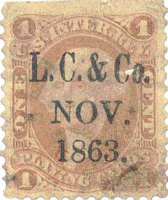The federal government first taxed playing cards in 1862 to support the Civil War. Except for 11 years (1883-1894), the tax remained in effect until it was repealed in 1965.
The U.S.A. did not use stamps on a card, but adhesive stamps on the package, the ‘Internal Revenue Stamps’. At some times there were different stamps used concurrently. Also revenue stamps not explicitly meant for playing-cards were used for them (and vice versa).
1862 – 1883
The text is ‘U. S. INTER. REV.’ or ‘U. S. INTER. REVENUE’, ‘PLAYING CARDS’, and the value, e.g. ‘FOUR – CENTS’. The value needed depended on the price of the cards. The stamp was hand-cancelled or stamp-cancelled.








Notes:
- ‘L.C. & Co.’ on the 1¢ stamp, that is for Lawrence Cohen & Co., cancelled November 1863.
- Text on the second (brown) 5¢ and on the 10¢ stamp is ‘PROPRIETARY’ instead of ‘PLAYING CARDS’, but the cancellation ‘S. H. & Co.’ is for the playing-card maker Samuel Hart & Co.; the stamps were cancelled in December 1865.
- You can see more of those overprints on pages prepared by Kristin Patterson.
Starting in 1864, playing card manufacturers were allowed to have their own ‘private die’ tax stamps.
1864 – 1883
A. Dougherty
2¢ stamp used from 1865-1866. 5¢ stamp used 1866-1877, a smaller version of it 1878-1883, and the 4c and 10c used 1864-1866.




1865 – 1874
Lawrence & Cohen
The 2¢ stamp in use 1865 to 1866 and the 5¢ stamp from 1865 to 1874.


1867 – 1873
Jno. J. Levy,

1876 – 1883
New York Consolidated Card Co.

1873 – 1880
Paper Fabrique Co.

1870 – 1875
Goodall
Note the similarity to the following stamp; the initials in the middle are those of Victor E. Mauger.

1877 – 1880
Victor Mauger & Petrie

1881 – 1883
Russell, Morgan & Co.

1880 – 1883
Eagle Card Co.

1866 – 1877
Samuel Hart & Co.
This final shown private die stamp is from

1894 – 1896
The text is ‘PLAYING CARDS – ON HAND AUG. 1894 – TWO CENTS’ and ‘U.S. – I.R.’.

1894 – 1917
The text is ‘PLAYING CARDS – ACT OF AUG. 1894 – TWO CENTS’ and ‘U.S. – I.R.’. The stamp was cancelled by the U.S.P.C.CO. with the date 5-1-01.

1917 – 1919
The overprint mentions ‘Act of 1917’, when taxes were increased, and on the second stamp also the new value ‘7 CENTS’.


1917 – 1919
Act of 1917 is referenced by the overprint ’17’. They were cancelled by N.Y.C.C.CO.


1917 – 1919
The overprint is the new value ‘7’. It was canceled by S.P.C.CO. (Standard).

For additional access to the remaining stamps issued through 1965, open the source of the above at
Peter Endebrock’s Playing-Card Tax Stamps from the U.S.A.

